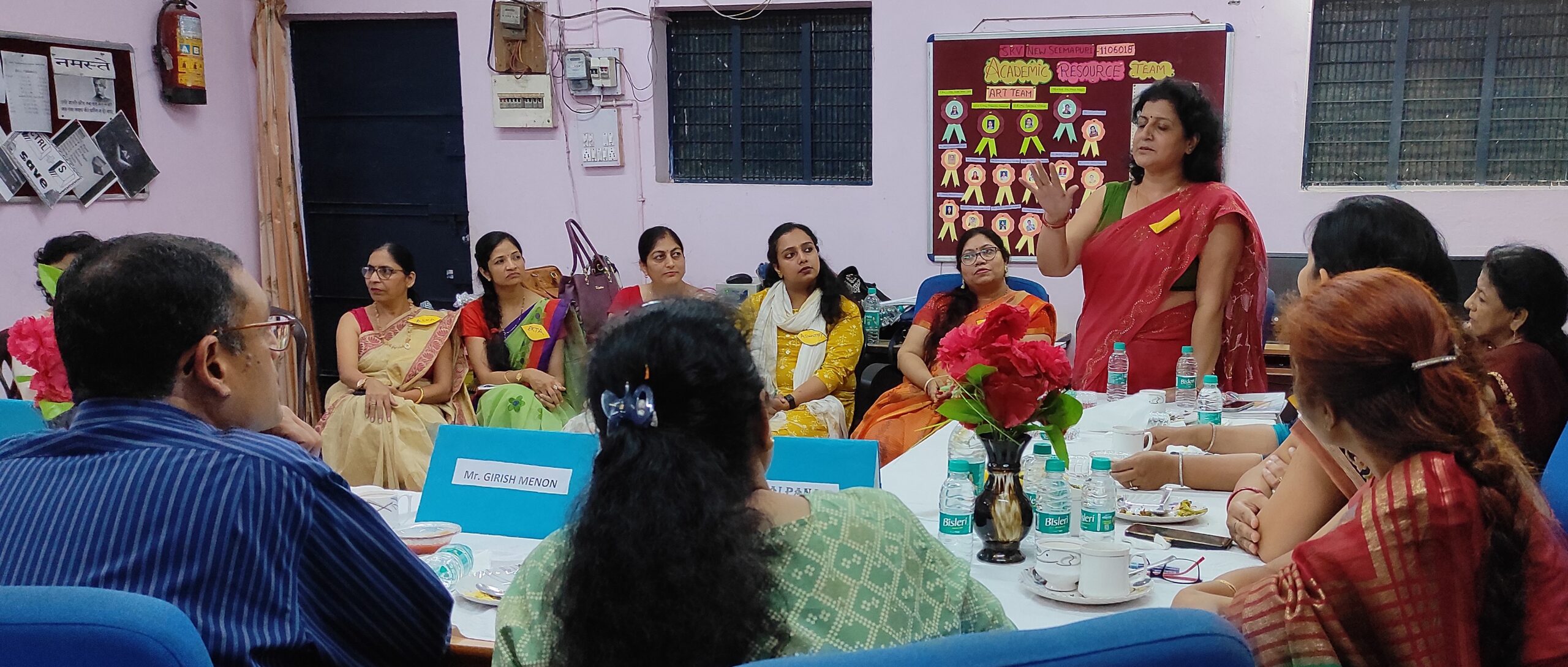SKV Seemapuri, a school in North East Delhi, was slightly hesitant to embrace the Teacher Development Coordinator (TDC) program. There was low exposure to the program and the teachers hardly had any time for additional assignments. The situation was further exacerbated by limited infrastructure and space constraints. However, when the TDC program established a strong peer network among teachers, a gradual shift could be seen from ‘How is this possible?’ to ‘Yes, it is possible’ in them. The TDC programme exposed teachers to boost classroom learning through innovative modes of engagement such as think-pair-share, reflective diaries and exit ticket strategy.
This case study shows how the TDC programme, facilitated by STiR, has the potential to motivate teachers to approach challenges with a growth mindset. The network meeting facilitated by the TDC in this school had a humble beginning with a tennis board for a projector screen.
Through the experience of a teacher, Ms. Ekta we see how strategies to foster classroom improvements discussed in network meetings helped to create an inclusive environment for students of different learning levels. This collaboration, saw a two-way shift in the students between 2019-2022:
- Improvement in academic competencies
- Boost in cognitive and socio-emotional growth
As a teacher of secondary classes, Ms Ekta often faced issues with students who did not pay attention. The network meetings along with the peer discussions, helped her discover the concept of interactive lessons. While talking about her experience, she shared “When I implemented these new teaching practices, children found it interesting. Previously, they tried to learn maths formulas without understanding the concept but now they try to understand first.” She explained the process she adopted to implement the concept of interactive lessons-
-
- Establishing classroom routines – To create an inclusive learning environment for all students, Ms Ekta adopted the ‘Do Now’ & ‘No Hands’ strategies to establish a classroom routine. She says “ ‘Do Now’ helped me establish a classroom routine wherein I put up a question on the board related to the topic taught in the last class. This boosted students’ memories. Similarly, ‘No Hands’ gave shy children the confidence to take part in class discussions”. Pre-planning questions, giving thinking time to children and asking child specific questions helped her to create a safe space for the children engaging them actively in the learning process.
- Encouraging peer learning and class discussion – To encourage peer learning, Ms Ekta initiated group discussion in her class. She would give a topic to the children along with some guiding questions and ask them to collaboratively work on it. She would facilitate the group discussion and encourage students to ensure participation of each group member. Ms Ekta says, “Children easily learn from each other. Such group work practice connects them with each other. Even when the teacher is not there children sit together and discuss.”
- Increasing retention and improving expression : After teaching a topic, every 2-3 days, Ms. Ekta would ask the children to write down whatever they remembered from the lesson. She kept the last 10 mins for this activity or sometimes used it at the start of the lesson. Ms Ekta shared, “I ask children to recall whatever they learnt in these 30 mins and pen down their thoughts within 2-3 mins.” This process helps in increasing their retention and expression skill.
This breakthrough could be achieved through network meetings which not only instil new ideas but are backed with action planning, feedback and reflection, a 360 degree teaching and learning approach. From a traditional learning setup, Ms. Ekta was able to slowly guide her classroom into becoming fear-free through behavioural, teaching and application methods.. This helped her students become confident and participate in classroom discussions, freely. “Generally, teachers expect for the children to sit silently while they speak. But my class is noisy and breaks beyond the traditional definition of a classroom”, she said with a smile.
The positive consequences of the changes Ms. Ekta introduced led to:
- Improvement in cognitive competencies : With more comprehension, fear of maths decreased in students. Their performance improved with conceptual understanding clubbed with writing skills. Students started showing more interest in her class as they loved to learn in new ways.
- Boost in curiosity and critical thinking: Ms. Ekta used the elaborative dice to encourage students exchanging questions and answers. This process helped build curiosity and critical thinking in students. When a child does a sum wrong, neither does she rebuke her nor does she give her the correct answer. Instead she asks the child,
- “Why did you apply this formula ?” or
- “Why did you put a decimal point here ?”
- “How was this formula derived? Let’s understand the reasons.”
She said, “Asking questions helps me understand how the students think, how much they have understood and then assess learning gaps.” I probe the children on each step and encourage them to reflect on mistakes and think harder on the “Why” of each step. This is very important to shift their mindset from rote learning to comprehension.”
Ms Ekta shared, every time she used an innovative teaching method, children responded to her positively. This increased her self esteem as a teacher. Ms.Ekta observed that there has been an increase in 20-30% scores of each child in her class. She said, “On average, children are showing improvements and have developed basic understanding in maths. More children are scoring passing marks. When I tell them about their gradual progress, they feel more confident. There is a shift from “I can’t do it”, to “Yes I can do it, yes I can learn!” She expressed “ I am happy to see that in my class, students feel motivated and happy.”


